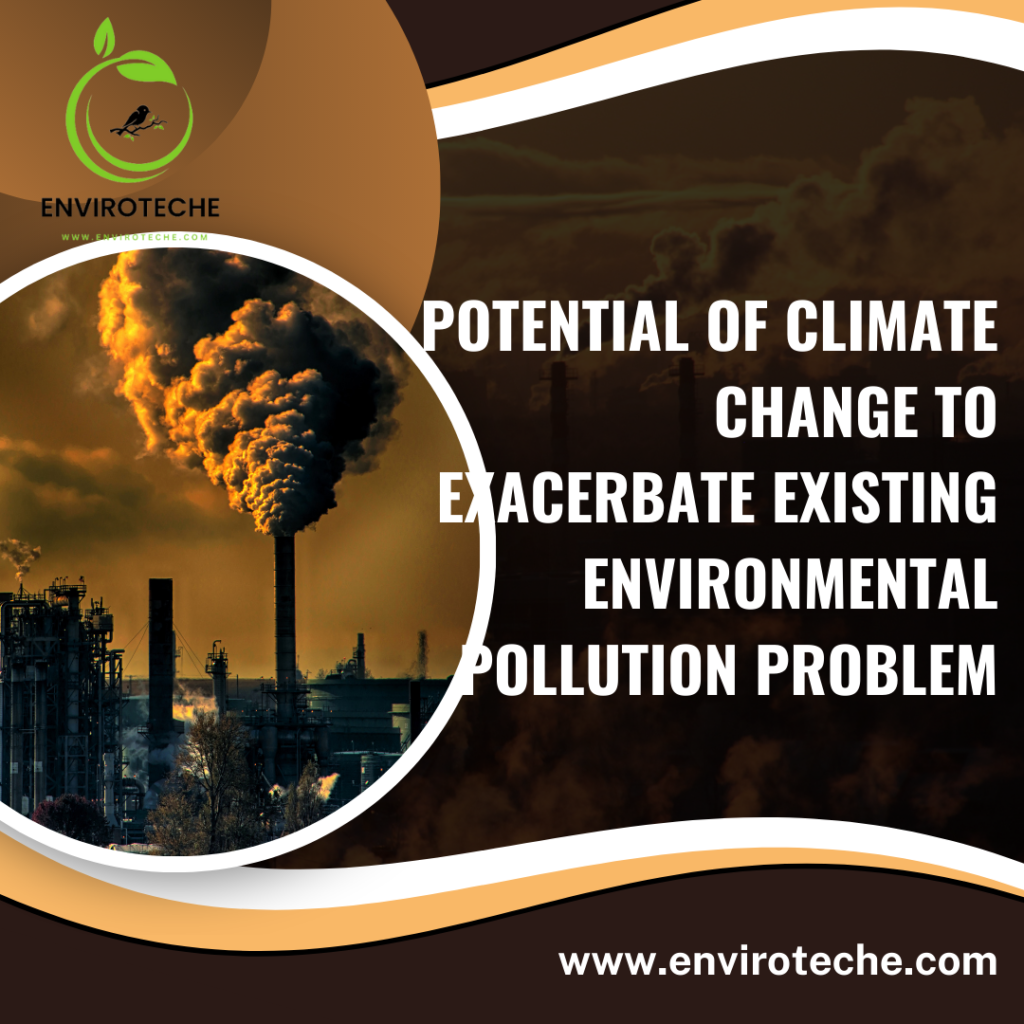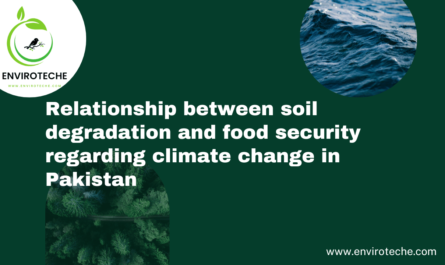
Irfan Haidri1, Yasir Bilal1
1Department of Environmental Sciences, Government College University Faisalabad
Abstract
One of the biggest problems of our time is climate change, which has a significant impact on both the natural world and human societies. It may exacerbate already severe environmental pollution issues, setting off a hazardous feedback loop that worsens the state of our planet. The delicate balance of our ecosystems is disrupted as a result of rising global temperatures, more extreme weather patterns, and disruptions to natural systems, which raises pollution levels in various environmental compartments. This blog explores potential ways that pollution issues already in place could get worse and emphasizes the urgent need for all-encompassing action to reduce these risks.
In this blog, we covered the impacts of climate change on weather patterns, heat waves, storms, and sea level.
Climate change Introduction:
Climate change interacts with and exacerbates already-existing environmental pollution issues, making it far from an isolated crisis. Examples from this blog show how pollution in the air, water, soil, and cities can all get worse due to climate change (Manisalidis et al., 2020). Climate change has the potential to make air pollution issues worse, which is already a major global concern. An unhealthy pollutant that poses significant health risks, ground-level ozone, is formed as a result of rising temperatures. The interaction of nitrogen oxides (NOx) and volatile organic compounds (VOCs) in the presence of sunlight results in increased ozone formation (Plocoste et al., 2018). Higher temperatures can also make it harder for pollutants to disperse, which can cause air masses to become stagnant and trap pollution in cities. Due to the effects of fine particulate matter (PM2.5) being exacerbated, the population is more likely to experience respiratory problems and cardiovascular diseases. Water bodies, such as rivers, lakes, and oceans, are impacted by climate change in a variety of ways, which can exacerbate water pollution. Increased algal bloom frequency and intensity can worsen water quality by reducing oxygen levels and causing algal blooms (Wang et al., 2023).
Heat wave
Heatwaves and climate change are clearly related. Heatwaves are occurring more frequently, being more intense, and lasting longer. Implementing strategies to reduce climate change and prepare for increasing heatwave risks is essential. This entails lowering greenhouse gas emissions, enhancing urban infrastructure and planning to lessen the impact of urban heat islands, and putting in place reliable early warning systems for heatwaves to safeguard vulnerable populations (Guo et al., 2018). We can address the effects of climate change and ensure a more resilient future in the face of heatwave events by being proactive. Heatwaves present serious health risks to people, and as a result of climate change, these events become more intense and have more detrimental effects on people’s health. Particularly among vulnerable groups like the elderly, children, and those with existing medical conditions, exposure to extreme heat can result in heat-related illnesses like heat exhaustion and heatstroke. Additionally, rising temperatures can aggravate cardiovascular and respiratory conditions and raise mortality rates. Health risks during heatwaves are exacerbated by the urban heat island effect, which is brought on by the concentration of buildings and human activity in cities (Parise, 2018).
Amplified Weather Patterns
Heatwave events are amplified as a result of climate change’s impact on weather patterns. Warmer temperatures have an impact on how heat is distributed throughout the planet, changing atmospheric circulation patterns and fostering the development and persistence of heatwaves. These intensified weather patterns may cause air masses to become stagnant, trapping hot air in a specific area for an extended period of time (Paravantis, 2022). Climate change can also affect the timing and length of heatwaves, lengthening them and raising the possibility of heat-related effects. Climate change-related weather patterns that are more extreme have a big impact on society and the environment. The well-being of people, infrastructure, and natural systems are all put at risk by factors such as increased frequency and severity of heatwaves, altered precipitation patterns, stronger storms, and shifting weather patterns. To ensure a sustainable and resilient future for our planet, immediate action is required to mitigate climate change and adapt to these amplified weather patterns (Khraishah et al., 2022).
Shifting Weather Patterns
Regional climates may change as a result of disrupted weather patterns brought on by climate change. This may cause atypical temperature swings, atypical weather phenomena, and alterations in wind patterns (Cianconi et al., 2020). Because people must adjust to new environmental conditions, changing these patterns can have significant effects on agriculture, ecosystems, and even human migration. Increased hurricane, typhoon, and cyclone intensity is a result of warming sea surfaces brought on by climate change. Warmer ocean waters give these storms the energy they need to intensify, increasing their wind and rainfall rates. Stronger storms can cause catastrophic storm surges, extensive flooding, and significant infrastructure damage, posing serious risks to coastal communities (Van Niekerk et al., 2022).
Changes in Precipitation Patterns
Climate change affects precipitation patterns, causing some regions to experience prolonged droughts while others experience more frequent and intense rainfall events (McCoy et al., 2022). A heavier downpour and a higher chance of flooding can result from warmer air being able to hold more moisture. On the other hand, drier conditions can cause protracted droughts that affect agriculture, water availability, and the risk of wildfires. Rainfall events that are more intense can make people more vulnerable to flooding as a result of climate change (Hudson et al., 2022). The more moisture that warmer air can hold, the heavier the downpours. Because of this, areas that experience these changing precipitation patterns are more vulnerable to flash floods, which can seriously harm human life, property, and infrastructure. Additionally, the likelihood of flooding has an impact on water management, disaster response, and urban planning. Ecosystems and biodiversity are impacted by changes to precipitation patterns. Changes in rainfall patterns can affect plant growth, pollination, and seed dispersal, upsetting natural cycles. The survival and distribution of wildlife species are consequently impacted. The vulnerability of ecosystems that depend on predictable precipitation patterns can result in habitat loss, species extinction, and potential ecosystem shifts (Ojima et al., 2021).
Conclusion
In general, climate change worsens already-existing pollution issues and establishes a risky feedback loop. Reducing environmental pollution and ensuring the wellbeing of our planet and its inhabitants require addressing climate change and its effects. As a result of altered precipitation patterns, pesticides and fertilizers are carried into water systems and cause soil erosion. Climate change-related drought conditions concentrate poisonous substances in the soil, lowering its fertility and impairing plant growth. The frequency and intensity of rainfall events increase as a result of changes in precipitation patterns, resulting in runoff that introduces pollutants from various sources into water bodies. Algal blooms, which reduce oxygen levels and release toxins into aquatic environments, can also be caused by warmer temperatures.
References
Cianconi, P., Betrò, S., & Janiri, L. (2020). The impact of climate change on mental health: a systematic descriptive review. Frontiers in Psychiatry, 11, 74.
Guo, Y., Gasparrini, A., Li, S., Sera, F., Vicedo-Cabrera, A. M., de Sousa Zanotti Stagliorio Coelho, M., Saldiva, P. H. N., Lavigne, E., Tawatsupa, B., & Punnasiri, K. (2018). Quantifying excess deaths related to heatwaves under climate change scenarios: A multicountry time series modelling study. PLoS Medicine, 15(7), e1002629.
Hudson, A. R., Peters, D. P. C., Blair, J. M., Childers, D. L., Doran, P. T., Geil, K., Gooseff, M., Gross, K. L., Haddad, N. M., & Pastore, M. A. (2022). Cross-site comparisons of dryland ecosystem response to climate change in the US Long-Term Ecological Research Network. BioScience, 72(9), 889–907.
Khraishah, H., Alahmad, B., Ostergard Jr, R. L., AlAshqar, A., Albaghdadi, M., Vellanki, N., Chowdhury, M. M., Al-Kindi, S. G., Zanobetti, A., & Gasparrini, A. (2022). Climate change and cardiovascular disease: implications for global health. Nature Reviews Cardiology, 1–15.
Manisalidis, I., Stavropoulou, E., Stavropoulos, A., & Bezirtzoglou, E. (2020). Environmental and health impacts of air pollution: a review. Frontiers in Public Health, 14.
McCoy, A. L., Jacobs, K. L., Vano, J. A., Wilson, J. K., Martin, S., Pendergrass, A. G., & Cifelli, R. (2022). The Press and Pulse of Climate Change: Extreme Events in the Colorado River Basin. JAWRA Journal of the American Water Resources Association.
Ojima, D. S., Conant, R. T., Parton, W. J., Lackett, J. M., & Even, T. L. (2021). Recent climate changes across the Great Plains and implications for natural resource management practices. Rangeland Ecology & Management, 78, 180–190.
Paravantis, J. A. (2022). Models and Forecasts on the Future Heat-Related Mortality Under Climate Change. In Urban Overheating: Heat Mitigation and the Impact on Health (pp. 129–154). Springer.
Parise, I. (2018). A brief review of global climate change and the public health consequences. Australian Journal of General Practice, 47(7), 451–456.
Plocoste, T., Dorville, J.-F., Monjoly, S., Jacoby-Koaly, S., & André, M. (2018). Assessment of nitrogen oxides and ground-level ozone behavior in a dense air quality station network: Case study in the Lesser Antilles Arc. Journal of the Air & Waste Management Association, 68(12), 1278–1300.
Van Niekerk, L., Lamberth, S. J., James, N. C., Taljaard, S., Adams, J. B., Theron, A. K., & Krug, M. (2022). The vulnerability of South African estuaries to climate change: A review and synthesis. Diversity, 14(9), 697.
Wang, Q., Li, Y., Zhong, F., Wu, J., Wu, W., Zhang, H., Wang, R., Duan, Y., Fu, Q., & Li, Q. (2023). Ground ozone rise caused by the larger emission reduction of nitrogen oxides than volatile organic components.


